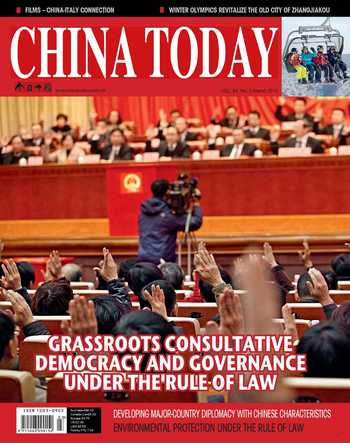Growing China Is Repaying the World
By ZHOU SHIJIAN

THE ongoing modernization drive in China is one of the largest in human history. It will provide modern living conditions for an estimated 1.5 billion people – that is, one and half times the combined population of the developed world – by the middle of the 21st century.
To ensure the success of this modernization drive, China needs to import huge amounts of resources, fuel, devices and consumer goods, boosting growth of the global market. In this context, the past few years have revealed three major changes in Sino-U.S. trade that best illustrate Chinas growth as the worlds biggest market.
The most important change, of course, is that U.S. exports to China have grown faster than imports from China. In 2000, the Chinese mainland was the 11th largest exporting market of the United States, but by 2007, it had overtaken Japan to become the third largest. Overall, U.S. exports to the Chinese mainland, Hong Kong and Macao grew from US $30.9 billion in 2000 to US $164.8 billion in 2013,making them the fastest growing markets for U.S. exports.
U.S. Secretary of State John Kerry has said that every US $1 billion worth of exports creates more than 5,000 jobs for the U.S., so US $164.8 billion means about 830,000 more jobs – the best gift for a country whose politicians have been splitting hairs over the high unemployment rate.
Whats more, such growth will remain stable in the long run, because in their quest to raise living standards Chinese people will continue to import more goods from the U.S. And even though the U.S. is trying to push forward the Trans-Pacific Partnership Agreement as a club dominated by Western economies, it cannot afford to ignore Chinas huge market potential.
Besides, Chinese investment in the U.S. is growing faster than U.S. investment in China. According to New Yorkbased advisory Rhodium Group, Chinas actual investment in the U.S. from 2003 to 2013 was US $25.5 billion and has continued to grow since the 2008 global financial crisis. By 2020, Chinas total investment in the U.S. is expected to exceed that of the U.S. in China.
The reasons why Chinese investors find the U.S. attractive are not only the rule of law, a well-trained workforce, advanced technologies and convenient energy supply, but also its huge consumption market. Chinas foreign exchange reserves have further boosted its overseas investment. As President Xi Jinping said at the Beijing APEC meeting last year, Chinas overseas investment will reach US $1.25 trillion in 10 years, second only to the U.S.

Moreover, the internationalization process of the RMB has been gaining pace. Since 2003, U.S. politicians have been putting RMB appreciation pressure on China to ease the trade imbalance. But the Chinese currency has appreciated at its own steady pace. This shows Chinas confidence in the RMBs internationalization process.
In fact, the RMB started becoming popular with neighboring countries and regions in the 1990s. Gradually, it started appealing to Western economies too. Today, offshore RMB reserves have reached RMB 2 trillion (US $319.7 billion), while China UnionPay cards can be used in 142 countries and regions. Also, China has been making efforts to ensure the RMBs entry into the Special Drawing Rights basket of the International Monetary Fund by 2020.
Nicknamed “paper gold,” the currencies listed in the IMF basket are automatically included by the worlds 220 economies in their foreign currency reserves. Up to now the basket has only four currencies – the U.S. dollar, the euro, the British pound and the Japanese yen. Every five years, the IMF deliberates which currencies to list in the basket, and the RMB is the strongest candidate for the 2020 deliberation.
In its report “Global Development Horizons 2011: Multipolarity – The New Global Economy” the World Bank said the U.S. dollar would lose dominance by 2025 and be replaced by a multinational currency system centered on the dollar, the euro and the RMB. China needs to take measures to ensure the World Banks prediction comes true, so that Chinese nationals may travel anywhere in the world with an RMB account.

